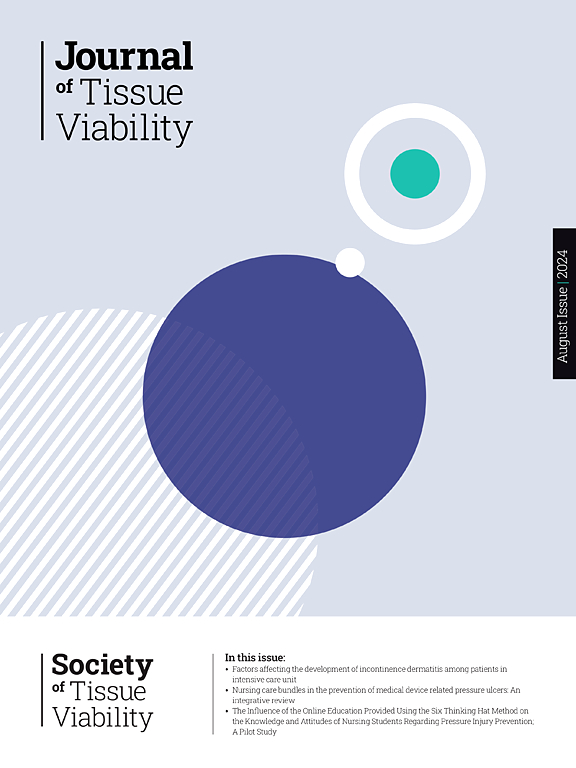Advancing burn wound healing with an innovative in situ gelling probiotic microparticle formulation employing quality by design (QbD) principles
IF 2.4
3区 医学
Q2 DERMATOLOGY
引用次数: 0
Abstract
Scientists investigated probiotic-containing dressings to address the challenges associated with burn injuries, namely infection and antimicrobial resistance. The present investigation sought to evaluate the impact of innovative probiotic-loaded microparticles with in situ gelling characteristics on infected burns. The strain, Lactiplantibacillus plantarum, was selected due to its demonstrated wound-healing potential. Subsequently, a formulation was designed to sustain the growth capacity of probiotics. Polymers with a high moisture absorption capacity were exclusively used to avoid powder dispersion from wounds. The formulation was stabilized through the reduction of water content using the spray-drying process. The ideal composition was identified by analyzing the influence of the spray-drying inlet temperature, polymer type, and concentrations on probiotic viability, process efficiency, swelling ratio, and flow properties of powders. Morphological analysis showed the presence of microparticles with significant exchangeable surface areas. The rheological properties of the formulation demonstrated its ability to withstand high temperatures and mechanical stress. Moreover, FTIR and DCS spectra provided evidence of interconnection between the polymers. Examination of the growth profiles of both formulated and free probiotics revealed a consistent growth rate and an extended lag time. Animal studies have shown that the optimal microparticles exhibited superior efficacy compared to the control groups across all parameters and displayed enhanced effectiveness against Pseudomonas aeruginosa. The proposed delivery method, with its simple application and prevention of normal flora transmission, may have the potential to improve burn wound infection treatments.

推进烧伤创面愈合与创新的原位胶凝益生菌微粒配方采用质量设计(QbD)原则。
科学家们研究了含有益生菌的敷料,以解决与烧伤有关的挑战,即感染和抗菌素耐药性。本研究旨在评估具有原位胶凝特性的新型益生菌负载微颗粒对感染烧伤的影响。该菌株是植物乳杆菌,因其具有伤口愈合潜力而被选中。随后,设计了一种维持益生菌生长能力的配方。具有高吸湿能力的聚合物被专门用于避免粉末从伤口分散。通过使用喷雾干燥工艺降低水分含量来稳定配方。通过分析喷雾干燥入口温度、聚合物类型和浓度对粉末益生菌活力、工艺效率、溶胀率和流动性能的影响,确定了理想的配方。形态学分析表明存在具有显著交换表面积的微粒。该配方的流变特性证明了其承受高温和机械应力的能力。此外,FTIR和DCS光谱提供了聚合物之间互连的证据。对配方益生菌和游离益生菌的生长曲线的研究显示出一致的生长速度和较长的滞后时间。动物研究表明,与对照组相比,最佳微颗粒在所有参数上都表现出优越的疗效,并显示出对铜绿假单胞菌的增强效果。该方法应用简单,可预防正常菌群传播,有望改善烧伤创面感染的治疗。
本文章由计算机程序翻译,如有差异,请以英文原文为准。
求助全文
约1分钟内获得全文
求助全文
来源期刊

Journal of tissue viability
DERMATOLOGY-NURSING
CiteScore
3.80
自引率
16.00%
发文量
110
审稿时长
>12 weeks
期刊介绍:
The Journal of Tissue Viability is the official publication of the Tissue Viability Society and is a quarterly journal concerned with all aspects of the occurrence and treatment of wounds, ulcers and pressure sores including patient care, pain, nutrition, wound healing, research, prevention, mobility, social problems and management.
The Journal particularly encourages papers covering skin and skin wounds but will consider articles that discuss injury in any tissue. Articles that stress the multi-professional nature of tissue viability are especially welcome. We seek to encourage new authors as well as well-established contributors to the field - one aim of the journal is to enable all participants in tissue viability to share information with colleagues.
 求助内容:
求助内容: 应助结果提醒方式:
应助结果提醒方式:


